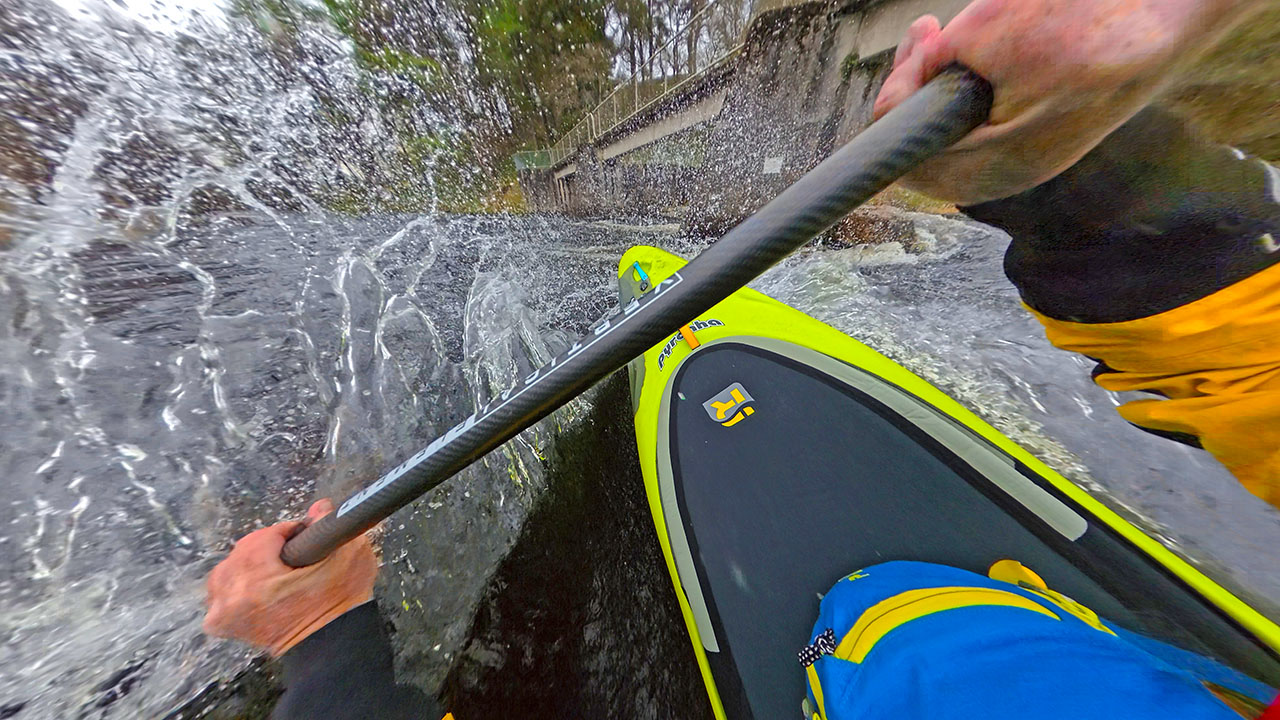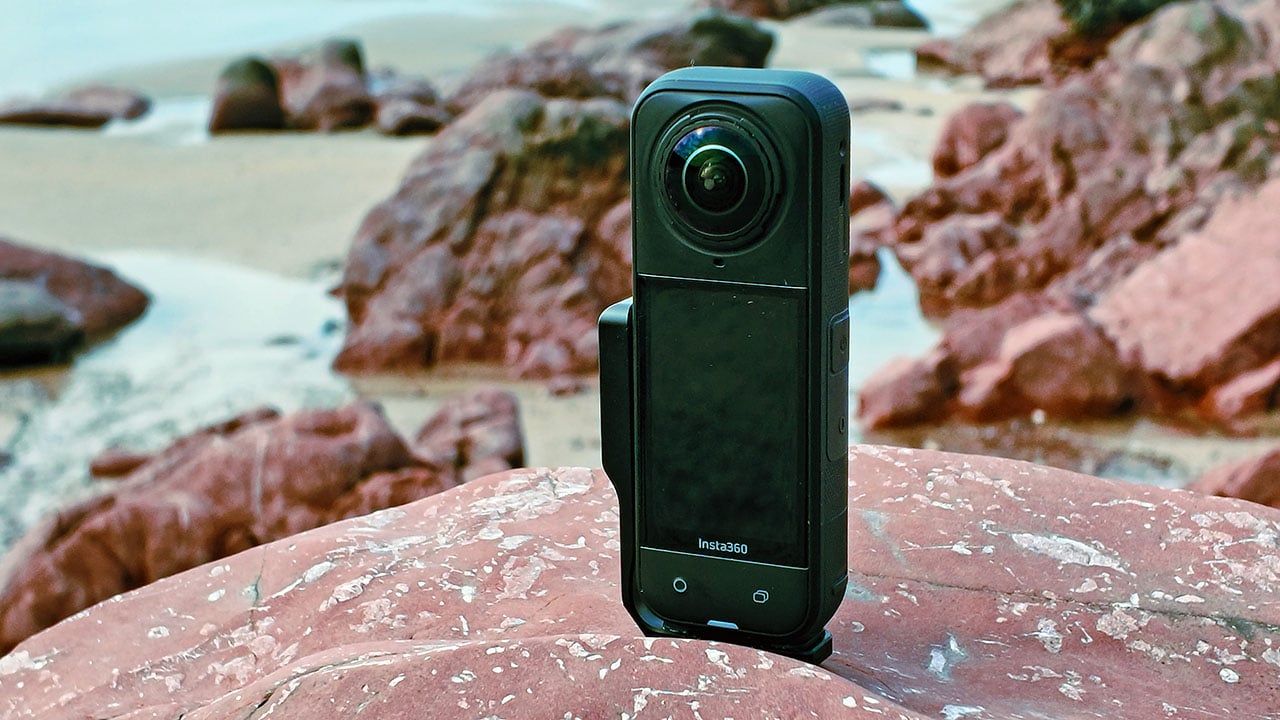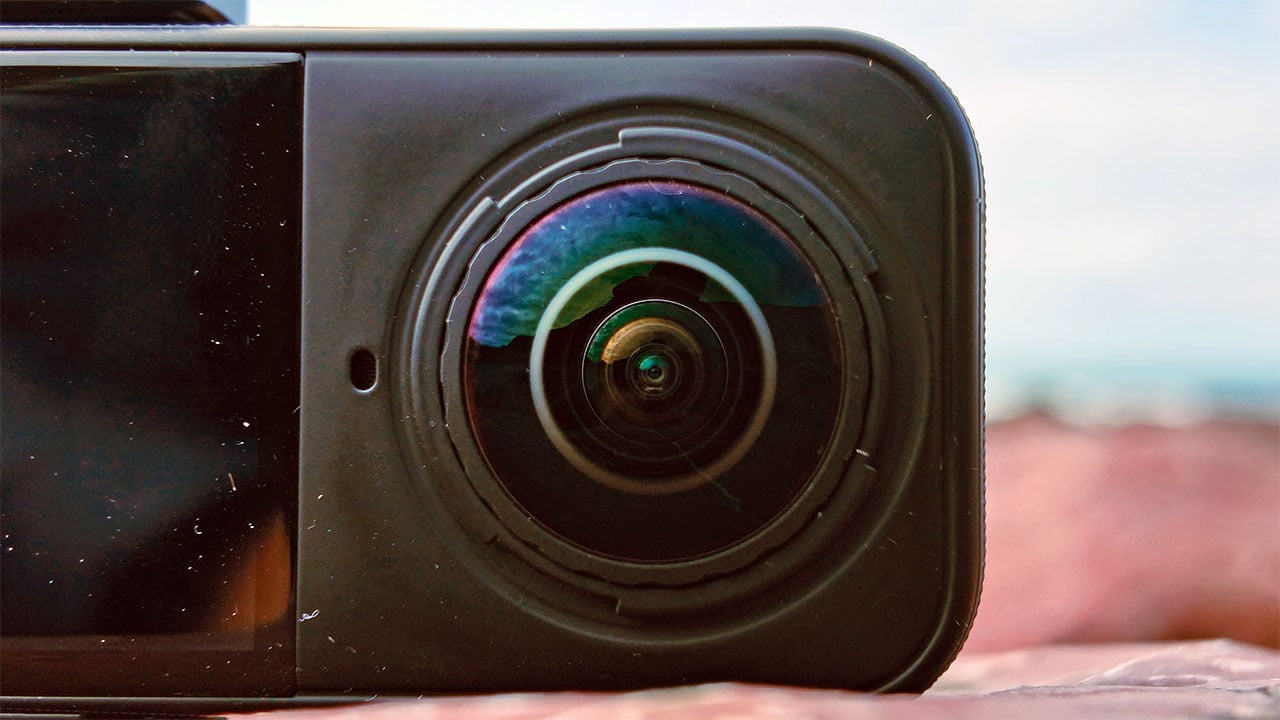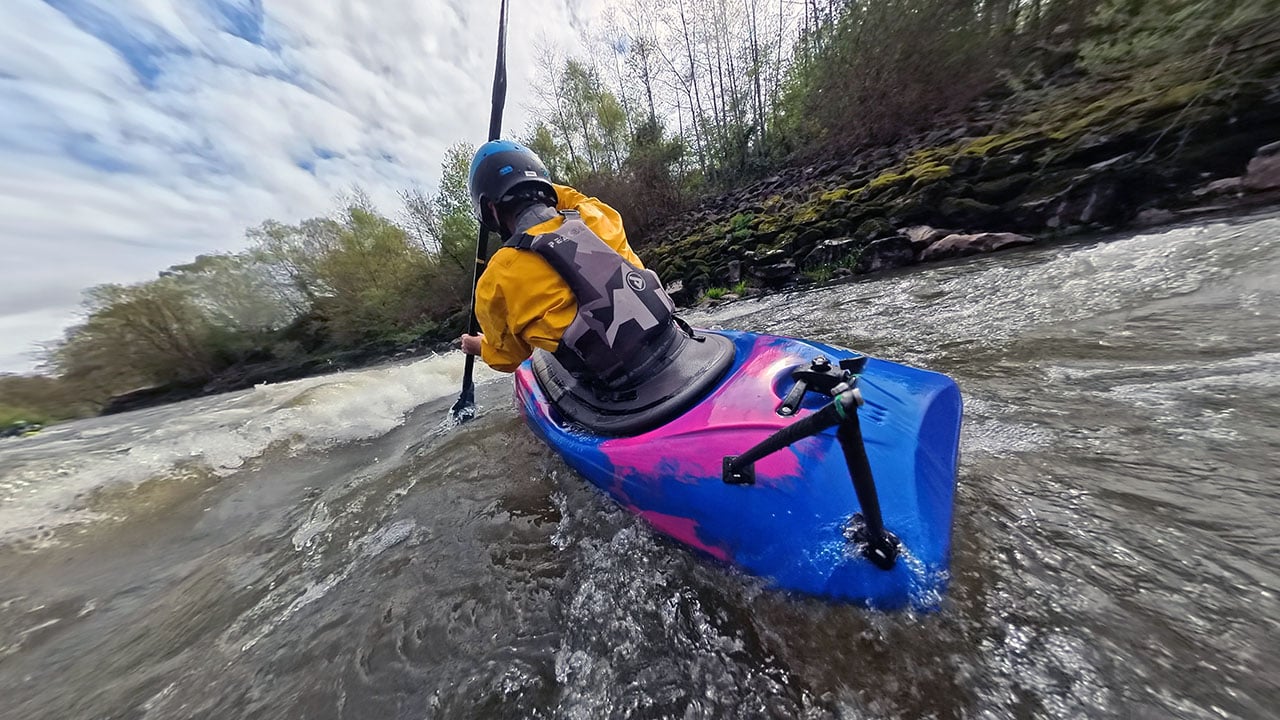
The Insta360 X5 is here, and while it’s clearly an evolution of the previous X4, the changes it brings are far more than just incremental.
In fact, several of the new features of the Insta360 X5 significantly increase the practical usefulness of a 360 camera in everyday creative scenarios, especially for users like me who might be placing the camera in riskier environments.
First impressions
The X5 is the same size as its predecessor, but the location of the USB door has changed and there’s a new microphone on the front with a built in wind filter. More on that a bit later. Overall, as you’d expect from Insta360 these days, the build quality is absolutely stellar. Weight-wise, the X5 comes in at 200g, which, surprisingly considering its size, is only 41g more than a GoPro HERO13. The battery capacity has been increased from 2290MAh on the X4 to 2400mAh in order to power the three new AI chips that inhabit the camera.
The new AI chips are the secret sauce to the X5, and I’ll come to the benefits of them later in the review, but they are an important development. Another small change to the X5 is the introduction of an Ace Pro compatible magnetic mount base for fast switching of mounts.

The X5 might look the same as the X4, but outward appearances are deceptive
User-replaceable lenses
One of the biggest hesitations I’ve had with 360 cameras in the past is how vulnerable the lenses are. If you’ve used these cameras before, you’ll know that a small scratch can ruin the image, introducing glare and artefacts that are distracting and annoying. And worse, getting those lenses replaced usually meant sending the entire camera off to the manufacturer at a cost. That’s not only expensive, but incredibly inconvenient, especially if you’re relying on the camera for ongoing projects or client work. The fact that the lenses on a 360 camera protrude so much makes them particularly vulnerable to damage.

User replaceable lenses make the X5 a much less risky proposition when it comes to creativity
The X5 completely changes this. The lenses are now user-replaceable, and Insta360 provides a dedicated kit with all the tools you need to safely remove and replace them. It’s a simple but powerful change to the 360 camera paradigm. I can now use the X5 in much more exposed or risky positions, such as POV helmet shots or kayak mounts, without the constant anxiety that a lens bump could take the camera out of commission.
However, you do need to be mindful about the conditions when doing the replacement. Insta360 recommends low humid levels when carrying out the work, which might be tricky during, say, the average British summer. But the job is a simple one, so I suppose you could perform the replacement inside a static air conditioned car if you don’t have a de-humidifier to hand. Humidity can introduce moisture behind the lenses, which could lead to fogging. But as long as you’re careful, it’s a relatively straightforward process.
Sensor improvements and low light capability
Another notable upgrade is the sensor. It’s 40% larger than the one in the X4 at 1/1.28”, and in real-world use, this makes a noticeable difference, particularly in low-light scenarios. This manifests itself noticeably in real use. Shadows are cleaner, noise is significantly reduced, colour tones are more subtly handled, and there’s much more usable dynamic range. Of course, it goes without saying that those three AI chips are doing a lot of grunt work too to improve the image.

5.7K mode with Active HDR engaged reproduces the subtle tones of a sunset very nicely
With the detail levels set to low, it all looks far more polished now, and that opens up creative opportunities that weren’t practical before because the camera reproduces detail that much better than the X4, despite the recorded resolution being the same.
Longer battery life
Battery life has also improved quite a bit, with times up to 185 minutes possible in 5.7K mode. That said, if you’re planning to shoot in 8K, or even recording extended clips in the higher frame rate modes, you’ll still want to keep a spare battery handy. The higher resolution modes do put more stress on the system, and that’s where some caveats start to appear.
Yes, the X5 can shoot in 8K, and when conditions are right, the results can be stunning with sharp detail and immersive resolution. However, in warmer environments the camera will heat up more quickly. While I haven’t had a shutdown myself, the heat buildup is definitely something you’ll want to keep an eye on if you’re recording for extended periods. It’s something to consider carefully if your workflow depends on long 8K takes or you’re working somewhere with high ambient temperatures.
This isn't a criticism unique to Insta360, thermal limits are a common issue in high-resolution compact cameras despite the ultra-efficient AI chips. But, it’s worth noting for anyone thinking 8K is the default recording mode. That said, there’s a 5.7K+ mode, which offers better image quality than the base 5.7K mode, and doesn’t stress the system so much.

Achieving 'impossible' shots is all in a day's work for a 360 camera
InstaFrame mode
One of the features I’ve found most useful on the X5 is called InstaFrame. When turned on, the camera will simultaneously record a 360 image alongside a 1080p flat image. This is a great mode to use where you might want a version of the video that doesn’t require any reframing or processing for quick upload to social media, while retaining a 360 version for more creative use later.
When using the rear facing lens, InstaFrame mode can track you, keeping you in frame no matter where the camera is in space. This tracking information is also embedded into the 360 file, so you won’t have to do the tracking manually in the app later.
10-bit colour, or lack of it
Now, onto one of the more disappointing omissions. While Insta360 has included the option to use iLog in 5.7K mode (but not 5.7K+ or 8K), there’s no 10-bit colour option. For a camera clearly targeting more serious creators, and people who want more grading flexibility, this feels like a missed opportunity.
The footage looks great straight from camera using the standard picture profiles, but if you’re someone who likes to do heavier colour grading, the lack of 10-bit limits your flexibility. It’s not a dealbreaker for everyone, but for log modes to really work well, 10-bit colour is really required.
Using the X5 as an action camera
While the X5 isn’t an out and out action camera, and it is larger than the Ace Pro 2 or GoPro, it can still be used as one. Ordinarily I wouldn’t use a camera with the form factor of the X5 on a helmet, but that’s exactly what I have been doing. I bought a frame from Insta360 that allows the camera to be mounted horizontally, rather than the much more awkward vertical orientation.

Another 'impossible' shot, and one that I wouldn't have risked with any other 360 camera due to the risk of the lenses being hit by the paddles
It doesn’t do my street cred any good in terms of looks, but the X5 in this configuration is actually more comfortable than a GoPro with the Ultra Wide Lens Mod installed. This might be due to the fact that the X5 is narrower, and so the centre of gravity stays closer to the helmet mount. Either way, I have found that I’m not really aware of it while it’s mounted.
For POV shots, 360 cameras produce the coolest looking results of any type of camera. You can get ultra-wide perspectives with zero fisheye distortion, giving a dynamic flowing look to any first person view. I absolutely love it. If you don’t want to mess around with the 360 image later, you can put the camera into FreeFrame Mode or just the standard video mode to record 4K footage you can use more easily.
Low light performance
One of the big selling points that Insta360 is focusing on with the X5 is its low light performance. The larger sensor and more powerful image processing would appear to give the X5 a nice performance boost on paper. But, does it translate to the real world?
I’m glad to report, yes it does. Comparing the X5 to the X4 in low light situations, and in general, there is a very noticeable bump in image quality. Noise levels are much reduced, and shadow detail is retained much better. Colours, such as during a sunset, are handled much better than the X4. I’d go as far as to say it’s a night and day difference. And that’s without taking into account the PureVideo mode.

PureVideo mode produces exceptionally clean results in the darkest of environments
PureVideo is the X5’s dedicated low light mode, and it can capture footage in some ludicrously dark conditions. It works very well, although unfortunately it doesn’t respect the sharpness settings that work for other modes, so it can look a bit digital. But, for shooting in environments where you wouldn’t otherwise get the shot, PureVideo mode could be a lifesaver. Despite the sharpness levels, it seems to produce a much better image on the X5 than the same mode on the Ace Pro 2.
Audio
Insta360 has introduced a new wireless mic for the X5, although we haven’t been able to test this. However, the X5 does have a new microphone with built in wind filter on the camera body, and it works very effectively when combined with the much more advanced wind reduction processing.
Even with the digital wind reduction set to maximum, there’s minimal effect on voices with hardly any of the ‘metallic’ effect that you would traditionally hear. When the camera is mounted to the end of a short selfie stick, voices are picked up very effectively, and it almost sounds like a studio mic recording. If you’re outside and don’t have a wireless mic to hand, the quality of the sound pickup from the X5’s built in mic at close range is impressive.
Speaking of selfie sticks, the X5 features a ‘twist to shoot’ option when the camera is mounted to one. The idea is that you quickly twist the selfie stick quickly twice to one side, and the camera will begin recording. Perform the motion again and it stops. Useful if the camera is on the end of an ultra-long stick. It seems to perform very reliably, too.
Conclusions
The Insta360 X5 is ideal for creators who value flexibility, ease of use, and durability in a 360 camera. If you shoot action sports, outdoor adventures, or immersive social content, this camera will serve you well. It’s also a great POV camera, and it really starts to make 360 feel more usable in terms of overall image quality and ease of use.
If you’re a filmmaker who needs post-production flexibility, or someone who expects to push colour grades heavily, the lack of 10-bit might be a limitation, despite the inclusion of iLog. That said, the X5 does produce a noticeably superior image to the X4. Even with the sharpness dialled to minimum, the X4 looked overly sharp compared to the X5. The X5, when the sharpness is set to low, produces a lovely creamy smooth image in comparison.
The Insta360 X5 doesn’t reinvent the wheel, but it absolutely makes the 360 format more usable, more robust, and possibly more appealing for a wider range of users who felt that the image quality of previous models wasn’t quite there. The user-replaceable lenses alone make a world of difference for how and where you can use it. Add in significantly better low light performance, and improved battery life, and you’ve got a camera that solves many of the pain points of its predecessors.
It’s not perfect, no camera is, but the X5 is an important step toward making 360 cameras feel less like a novelty and more like a genuinely useful creative tool.
The Insta360 X5 is available now for $549 (£519, €589). Watch the video review below.
tl;dr
- The Insta360 X5 features user-replaceable lenses, addressing previous concerns about lens vulnerability and simplifying repairs, making it ideal for risky shooting scenarios.
- The camera has a larger sensor that enhances low-light performance, resulting in cleaner shadows, reduced noise, and improved color tones, allowing for more creative opportunities.
- Battery life has improved significantly, offering up to 185 minutes in 5.7K mode; however, shooting in 8K can lead to quicker heat buildup, which users should monitor if recording for extended periods.
- The introduction of three new AI chips boosts image quality and processing efficiency, enabling features like Active HDR and better overall performance compared to its predecessor.
Tags: Production Cameras Action cameras 360 video 360 cameras


Comments